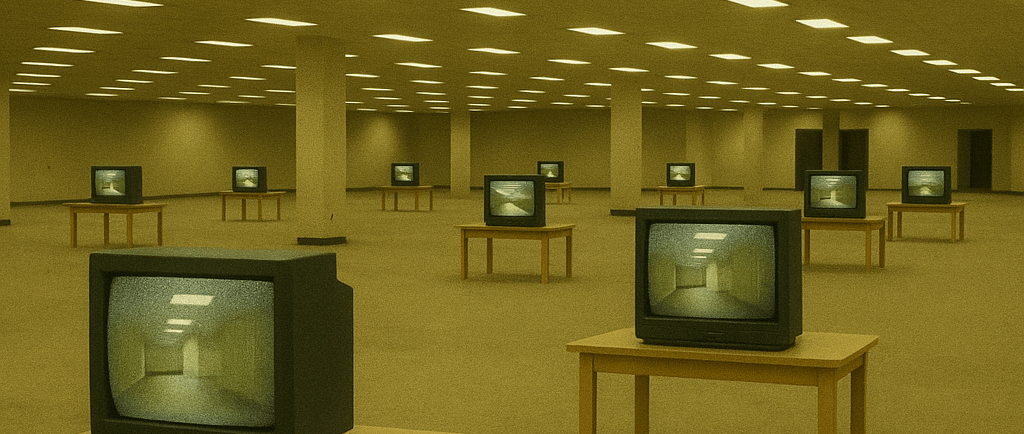The Backrooms Are Real, and They Don’t Want You to Know
The official story...if you believe what they feed you on Wikipedia...is that The Backrooms started as a creepy little 4chan post in 2019. Just an internet joke. A meme. A harmless "liminal space aesthetic" dreamscape. Nothing to see here, right? Wrong.
Obscure Arcana Staff (or what's left of us)
10/11/20253 min read


That story is the cover-up. A sanitization campaign
Let’s break it down.
The “Official” Origin
According to the Wikipedia psyop, the Backrooms were born when an anonymous user on 4chan’s /x/ board shared a photo of an eerie, yellow-lit, windowless room and said:
“If you're not careful and you noclip out of reality in the wrong areas, you'll end up in the Backrooms…”
That’s supposed to be fiction. But here’s my first issue: Where the hell did that photo come from?
For years, nobody could trace the image’s origin. It was an internet ghost. Then, suddenly...in 2024, after a bunch of dedicated researchers started asking real questions...a "Twitter user" just happened to "find" the source in an old HobbyTown renovation blog?
Yeah, okay.
EDITORIAL NOTE:
A mysterious photo with no known source appearing out of nowhere, spreading virally, and then being conveniently "explained away" years later with a HobbyTown blog post? Classic post-event disinformation tactic. Create confusion. Inject plausible deniability. Erase the trail.
The “Liminal Space” Aesthetic Is a Smokescreen
The article leans heavily into the idea that the Backrooms are just another flavor of the liminal spaces trend...those weird, empty places that feel off somehow. Empty hallways, dead malls, glowing office spaces at 3AM.
But ask yourself: Why do so many people feel like they've been there? Why do we get that gnawing sense of déjà vu?
Because the Backrooms aren't fiction. They're memory fragments. Residual echoes of a real place your mind can’t process.
EDITORIAL NOTE:
What we call “liminal” might be your brain struggling to recall an encounter you weren’t supposed to remember. Memory scrubbing is a real thing. You think MK-Ultra ended in the ‘70s?
No-Clip Theory: More Than A Metaphor
The term “noclipping” comes from video games...it means passing through solid objects or boundaries. Wikipedia treats it like a joke metaphor. But think deeper.
Is it that absurd to think reality has seams? That space-time isn’t seamless? That glitches, entry points, tears, exist?
Hell, CERN has openly discussed micro black holes. Quantum tunneling is real science. There are stories of people vanishing mid-step, slipping “out of sync.” We call them “missing persons.” What if they just noclipped?
EDITORIAL NOTE:
They’ve always told us “don’t go into abandoned buildings.” Maybe it’s not because they’re unsafe...but because they’re unstable.
Kane Pixels: Pioneer… or Gatekeeper?
Kane Parsons...aka Kane Pixels...created the viral Backrooms Found Footage videos. He’s praised for “bringing the concept into the mainstream.”
But how did a 16-year-old create hyper-realistic horror using Blender and After Effects that captures the exact subconscious dread people feel from the Backrooms?
Was he channeling something? Or being fed data?
And now he’s working with A24, James Wan, and Shawn Levy? That’s not indie horror. That’s a control operation.
EDITORIAL NOTE:
Parsons’ short films depict Async, a corporation that opens a portal to the Backrooms. Where did this detail come from? He says it’s fiction...but it lines up eerily well with DARPA patents on spatial displacement from the late 1990s. Look it up.
Entities and Levels: Too Consistent to Be Random
The article says fans just made up entities and levels...Level 0, Level 1, Level 2, and so on. Hostile creatures. Environmental hazards.
But what kind of crowdsourced fiction gets this internally consistent across platforms, languages, and communities?
People who’ve never met describe the same smell of wet carpet. The same fluorescent hum. The same feeling of being watched.
Coincidence? Or is the crowd remembering something real...poorly, through the haze of trauma and dream logic?
EDITORIAL NOTE:
Collective storytelling is sometimes just shared trauma trying to claw its way into the light.
“They” Buried the Room
Let’s go back to that infamous photo: the yellow walls, the damp carpet, the oppressive lights. Wikipedia now says it was taken in 2002 during a HobbyTown renovation in Oshkosh, Wisconsin.
Funny. Because that building? It’s completely redesigned now. The original layout is gone. You can’t get in there. Revolution Racing tore it all out. Just like they were told to.
EDITORIAL NOTE:
If someone told you a specific room was a dimensional thin spot, what’s the fastest way to neutralize it? Destroy the room. Rezone the building. Say it was just “water damage.” They even note that “no windows were visible.” That room was a sealed testbed.
Why Are There So Many Games?
The article lists dozens of Backrooms games...some just months after the concept “appeared.”
Why the rush?
Because simulation is acclimation.
Let people explore the Backrooms virtually. Desensitize them. Make the real thing feel familiar, even safe.
EDITORIAL NOTE:
It’s not about horror. It’s about conditioning. Games are practice runs. You’re being taught how to survive the space before you’re dropped in it. Why else would they gamify existential dread?
Final Thought: You Already Know They’re Real
The Backrooms aren’t “creepypasta.” They’re invasive memories from a dimension we’re not allowed to acknowledge.
That old office building you got lost in once? That hotel hallway that went on too long? That flickering light in your garage that buzzes even when it’s off?
That was it.
You brushed up against the veil. And it buzzed back.
Keep your eyes open. Watch for seams. And for god’s sake...don’t noclip alone